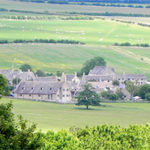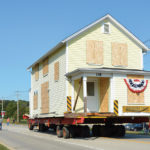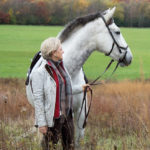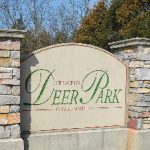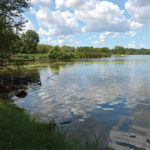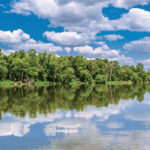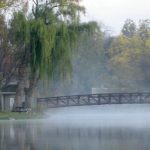Deer Park: Harmony in Countryside and Commerce with Respect for the Past and Optimism for the Future
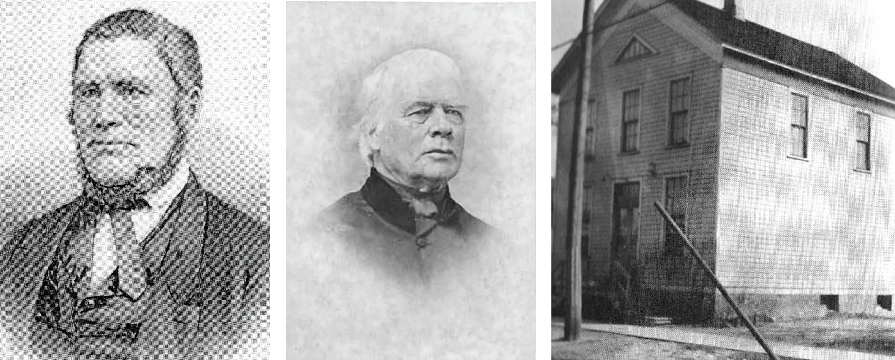
Left: John Robertson, Sr. Middle: George Ela. Right: George Ela’s store in 1854. (Photos: Tales of Old Barrington)
Approximately 4,200 people live in an area whose borders weave from Lake Cook Road, east to Route 12, west along Cuba Road to Lake Zurich Road and north to Middlefork and Rainbow Roads. Between Barrington, North Barrington, Lake Zurich, Lake Cook Road, and public open spaces, a community has been forged, with its own character, and its own sense of place. Its leaders, since 1957, have guided a balance of development for spacious family residential neighborhoods, an elegant commercial environment along its eastern frontier, and a western frontier that reminds us of pre-settlement days in preserved and restored prairie lands.
It was in 1834 that the first of the pioneers from the eastern states discovered the fertile open spaces northwest of Chicago, within distance to a beautiful lake accessible along trails first trodden by Native Americans, some of whom, Pottawatomie, were still in the area, drawing out their time after the 1833 Treaty of Chicago had decreed their exodus to west of the Mississippi. Initially called Cedar Lake, it was Seth Paine, one of the earliest residents of the area, who renamed the beautiful body of water Lake Zurich, which would give the town that grew along the lake its distinctive chalet style architecture. The lithograph (left) shows the home and farm of John Robertson, Sr. on the shores of Lake Zurich.
George Ela and John Robertson were among the earliest settlers on the land south of the lake, with Government Survey maps placing George Ela southwest of what is now Lake Cook and Quentin Roads in Deer Grove. From a family of merchants in Lebanon, N.H., in 1835 Ela laid claim to over 100 acres in Deer Grove where he had a house and store and was reported to be the only white settler for miles around. According to a Deed recorded in Lake County on December 17, 1841, he purchased 100 acres from Andrus Rupel across County Line Road in the present-day Rue Valley subdivision, where his home also housed a general store. He acquired another 40 acres in what is now Kildeer’s Pine Valley. In all, Lake County would record over 100 land transactions involving George Ela in both Ela and Cuba Townships.
While John Robertson Sr. was extending his claims throughout the area, eventually owning parcels totaling almost 2,000 acres, George Ela was leading an active civic life. On March 23, 1846, a Post Office named Serryse was established with Ela as Postmaster, located in his general store on Quentin Road. Ela ran for election for the Illinois House of Representatives in 1846 and won. He voted for Stephen A. Douglass for United States Senator on December 2, 1846. In the House, in January 1847, he introduced a Bill to legalize roads laid out in Lake County and represented Lake County at the state Democratic convention in 1848.
An Early Link to Barrington
By 1849, with the Government mandate to legally name Townships, Lake County designated Township 43 North, Range 10 east of 3rd Principal Meridian in honor of George Ela, as one of the first settlers, a prominent citizen and the county’s representative in the State Legislature. But quick to see business opportunities, when the Illinois and Wisconsin, later the Chicago and Northwestern Railway established the town of Barrington west along the County Line Road in 1854, Ela was one of the first to open a general store at the east side of the tracks, thus establishing an early link between Barrington and the future Village of Deer Park. Ela led the way to expand trading opportunities for those early farmers.
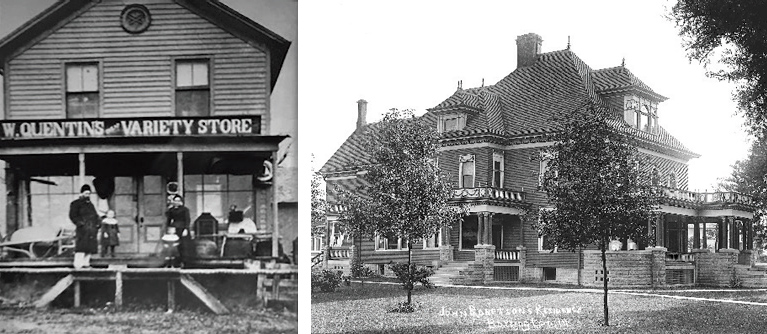
Left: William Quentin’s Cheap Variety Store. Right: The John Robertson, Jr. home was renovated in 2013-15 and is now known as Barrington’s White House.
A Township Named for George Ela
In 1846, the mail stagecoach route went south from Lake Zurich on Ela Road to Cuba Road, and west across Cuba Road towards Dundee. In 1853, the Chicago Tribune listed mail arrangements as being between Darien, Wisconsin; Deer Grove, Serryse, Lake Zurich, Lamar, McHenry, Kingwood (maybe Ringwood) Hebron, and Walworth, Wisconsin. After the township was named for George Ela in 1850, the first appointed township postmaster was Abram Wandawerker with the office located in his store at Wandawerkers Corners, Long Grove and Rand Roads. The next appointee was Daniel Porter, and then in 1854, William Quentin’s Cheap Variety Store at the southwest corner of Quentin and Rand Roads was designated the Ela Post Office. Rand Road was a stage route by 1845, and later named for Socrates Rand, an early Lake County settler. In the decade before Barrington was established, Lake Zurich had become a thriving center for commerce, and therefore the areas around it were quickly settled. Initially, the pioneers were from the east, breaking the prairie, staking their claims, building their homesteads using the logs cut from the stands of timber that punctuated the landscape.
Some would not stay. When word of the California Gold Rush spread across the country beginning in 1848 some men, and entire families, pulled up stakes and began the trek west to the new land of opportunity. Through Chicago in all directions an infusion of German emigrants joined the settlers of English, Scottish, and Irish origins who had come from the east and Canada.
The best early map of Ela Township is from 1861, and in the sections that 100 years later would be the nucleus of the Village of Deer Park we find a melting pot of families whose native languages and dialects were reflected in the churches they built, the stores and wagon shops and livery stables, and inns and restaurants they opened. They were the Meyers, the Froehlichs, the Reeses, the Kropps, the Websters, the Schufeldts, the Putnams, the Elfrinks, the Vandawerkers, the Pomeroys, and engraved into the history books the Robertsons and the Davisons.
Ela men went to the Civil War, among them Joseph Whitney, who in 1860 had married Mary Delano in Barrington. From his service in the War, a hundred years later, a remarkable and moving book was published of the letters he sent home. He always signed off “Kiss Clara for Me”, desperately missing the baby daughter he had left behind. Similar to those included in Ken Burns’ “Civil War”, Joseph Whitney’s letters were eloquent in describing the suffering around him.
A Shocking Crime
Perhaps there were disagreements, maybe fisticuffs outside the liquor store, assuredly petty larceny, and domestic violence which fell under the Justice of the Peace and the Sheriffs jurisdiction, but none compared to the events of September 8, 1877. Nothing gives more immediacy to that day than the report from the Chicago Daily Tribune of September 11, 1877.
“John Robertson and the Tragedy of Rainbow Road” is the headline: “Nothing in the whole history of Lake County has ever produced a tithe of the excitement developed here over the killing of ‘Squire John Robertson’ by Peter Davison…..The death of one of its most prominent citizens in this manner has called forth such an expression of public sentiment as is very seldom manifested in the rural districts.”
The article continued: “The cause of the terrible incident was a road dispute. The road to Honey Lake, today known as Rainbow Road in Lake Zurich, had been in place some 40 years, but farmer, Peter Davison, decided it was too close to his orchard and petitioned the Road Commissioners to have it moved. For a couple of years preceding the incident, Davison had repeatedly blocked the old road with barriers using logs or fences and harassed travelers.”
The Road Commissioners, headed by John Robertson, wanted to move the road, but this required a lengthy approval process for taxation. Tired of the situation, on September 8, 1877, they headed out to Rainbow Road where they found that Davison had built a rail fence with a board fence on top of it secured with a chain and padlock. One of the Commissioner’s hired men took part of the fence down, before Davison, his son Charles, and his wife Martha threatened them with clubs and a fence rail. As the threats continued one of the commissioners went to get a warrant to arrest the Davison men.
Told to continue taking down the fence, the hired man was hit with a club by the younger Davison. When the club was taken from Charles Davison he cried out “I am assaulted” and drew a revolver on the man. Robertson tried to calm Peter Davison down, but he leveled his revolver at the commissioner and fired. Shot through the chin, Robertson was conveyed on a wagon to his home by the lake in Lake Zurich, where he died four hours later. Edward Clark, Robertson’s son-in-law, went to arrest Davison and found him smoking a cigar. He claimed at trial that the shooting was accidental. But he was found guilty and sentenced to 14 years in the penitentiary, of which he may have only served two years.

Left: The Pomeroy one-room schoolhouse. Right: Old Maud.
The Grandest House in Barrington
The Commissioner’s son, John Robertson, Jr. moved to Barrington and went into the banking business with his son-in-law Ed Clark. He became a successful banker and a respected community leader. In 1898, he and his wife Julia built, what was at the time, “the grandest house in Barrington” at 145 West Main Street. Today it is the community and cultural center, Barrington’s White House.
At the time of this incident, John Leonard Vehe had owned his 80-acre farm on Cuba Road for over 10 years. When Peter Davison’s possessions were put up for auction, John Vehe purchased a wooden corn planter, where the corn was sown by manipulating the handles on the bins to release the seed. Almost a hundred years later, his grandson, Edwin Vehe, donated this corn planter to the Barrington Historical Society, located then in the Wichman Blacksmith Shop on Station Street. It became the centerpiece for school children’s visits where they learned how labor-intensive farming was in pioneer days.
When the Robertson and Davison events occurred, Reuben Pomeroy was settled on 200 acres at the southwest corner of Ela and Cuba Roads. His son would own and operate a flour mill in Barrington between Franklin Street and the railroad tracks. One of the best remembered country schools was on his land near Ela and Cuba Roads, known then as Pomeroy’s Corners. Dan Pomeroy inherited his father’s land, a lot of which was marshland. In 1889 the Elgin, Joliet and Eastern Railway obtained right-of-way across his property for the construction of their loop line from Gary, Indiana to Waukegan. It was necessary to sink deep pilings to support the railroad, a process which was described by Emaline Hawley Brown in her letters written from Barrington’s Octagon House. She noted that crowds went over to the slough to watch the men driving in the pilings with steam hammers, it was great entertainment. She commented that “everyone and his dog was there”. The freight line carried some passengers, and for the first time, Ela Township was foreseeing the new century. The sound of the steam engine and train whistle was heard in the land.
With their beautiful lake environments both Wauconda and Lake Zurich had become attractive resort communities with clusters of cottages offering inexpensive vacation accommodations, and Rand Road along the eastern border of Ela Township became a primary route to these towns. But smaller farms and hardworking farmers still sustained the economy of the countryside. Ela Township had early on, simply through use, developed a network of trails and roadways that took its farmers and merchants to nearby towns including Barrington, Palatine, and Wauconda.
In the new century, as the automobile began to bump along the dirt roads entrepreneurs emerged. Among them were men from Wauconda and Lake Zurich, notably Robert K. Wynn and Justin K. Orvis. In 1912, their plan was for an electric rail line that would span 75 miles of Lake and McHenry Counties and connect to the Chicago and Northwestern station in Palatine. It was hoped to bring weekenders and summer vacationers to the resort towns on the lakes.
Their Palatine, Lake Zurich, and Wauconda Railroad, (PLZ&W) was built finally only as 11 miles from Palatine to Lake Zurich, crossing Lake Cook Road into that part of Deer Park that bordering along Rand Road, and northwestward to a station in Lake Zurich across Main Street. A trestle took the line over the E.J.& E Railway. This line has achieved a romantic history becoming referred to as “Old Maud” after the secondhand engine that was purchased from the Chicago and Northwestern Railway. It was a freight, passenger, and postal line. It was also facetiously known as the PLZ & Walk Railway; accidents and breakdowns were so frequent, and because of second-hand equipment and disrepair it often became hard for the engine to negotiate the steep incline over the trestle and passengers would be asked to get out and walk. In spite of some successful times, including one weekend when it carried almost 3,000 passengers to the lakes, the line went into receivership several times and was ordered closed in 1924. Young and older residents of the time left a wealth of recorded memories, many collected at the Ela Township Historical Society.
Rand Road
Rand Road was paved in the mid-1920s and designated as Route 12, increasing automobile traffic to the lake communities and southern Wisconsin resort towns. But essentially, for over a century since its first settlement, Ela Township, and thus the lands that would become the Village of Deer Park, retained their rural use. Some farms thrived through the stewardship of several generations. The principal crops were corn, oats, barley, hay, and some soybeans. Most farmers had a few dairy cows, and some had hogs, most had chickens. Unlike Barrington, where dairy farmers either provided milk to the many cheese factories, or sent their milk to Chicago, lining the cans up by the Barrington depot for the early train, Ela farmers mostly drove their milk to the Lake Zurich Creamery. Almost every farm had a vegetable garden, and farmer’s wives canned fruit and vegetables and meat as provisions for the harsh winters.
But by 1950, developers had begun buying parcels from which a family could no longer sustain a living. In the early days, children were an essential part of the family farm, their formal schooldays limited to the winter months while summertime saw them working in the fields. But the First World War had brought about societal changes, especially when for the first time, boys in their teens had gone overseas to be matured in the horrors of the battlefront. The Second World War saw another generation depleted in action across the world. But in both wars, agriculture had been the backbone of the national effort to survive. Farms across America, and the millions of Victory Gardens, the backyard plots that sustained civilians and the military, still ranked in the forefront of the national consciousness. But in mid-20th century that changed, as consolidation, industrialization, and efficiency took over.
A 1956 Plat Map of Ela Township shows a breakdown to smaller lots and a few high-density subdivisions closer to Route 12 and Lake Cook Road. Notable among original families still owning large acreage was Edwin Vehe with 80 acres on Cuba Road, C. J. Leonard with 80 acres west of Vehe at the corner of Ela and Cuba, and several parcels to which are assigned the name of Mary Patten. She was a niece of John Robertson, Jr. who had built Barrington’s White House, and she was a beneficiary of the extensive Robertson holdings. She died in 1955, and her properties would be included in the new Village of Deer Park. Another of the old names on this map was James Quentin, with 18 acres left on Quentin Road, just north from where his great-grandfather had opened Quentin’s Cheap Variety Store.
The exodus from the city to the suburbs was in full swing by the 1950s, and older residents were seeing the opportunity to sell and retire. But there were also some who saw the possibility of an open space community with carefully controlled zoning at its core. The Village of Deer Park was incorporated on November 13, 1957, within a border that sprawled from Ela and Cuba Roads, to Lake Cook Road and Route 12. Zoning ordinances were enacted requiring minimum one-acre lots. The lack of any public sewer and water facilities was a factor in maintaining large lot sizes. The first Village President was Clarence Voras.
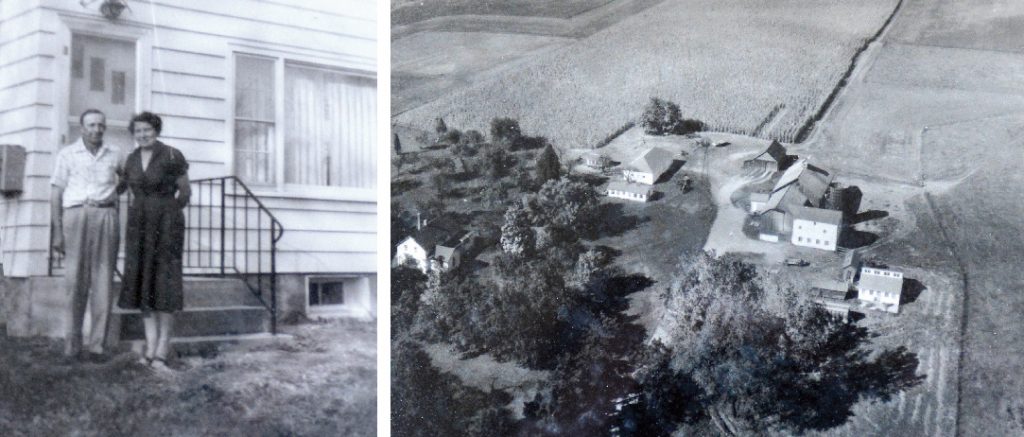
Left: Eddie and Mae Vehe at the farmhouse in 1956. Right: An aerial view of the Vehe Farm.
Backyard Missiles
Today, not a trace remains of a Cold War relic that by some unknown bureaucratic process had come to 16 acres on the east side of Quentin Road between Lake Cook and Long Grove Roads. Needing a defense against potential Soviet air attacks, the U.S. developed a two-stage supersonic missile that could be guided to its target by radar and computer. When the Soviet Union developed long-range bombers capable of hitting targets within the continental U.S., the plans for the missile defense system became reality.
Nike’s 265 missile sites were constructed in defensive rings around major urban and industrial areas in 28 states. One of the country’s defense areas was Chicago-Gary with 18 sites in Illinois and 5 in Indiana. There were four sites in Lake County: Fort Sheridan (C-98), Libertyville (C-92 and C-94) and Barrington (C-84), located on the Quentin Road site. It was deep underground, with small nondescript buildings above ground, surrounded by a fence with security gates. It was operational between 1956 and 1963, when Soviet military strategy changed and U.S defense dollars were needed elsewhere.
Barrington’s C-84 served one more purpose before it was destroyed and filled in. The Lake County Discovery Museum used the space underground in its early years to store its collections. Some Lake County records were stored there. This writer remembers taking an elevator down, deep underground when Museum collections, most of them acquired by Lake County historian Bess Bower Dunn, were stored in less-than-satisfactory conditions.
This was not the end of the story for the Nike site. Lake County was looking at alternatives for the property, and one proposal called for a juvenile detention center. By this time, the Barrington Area Council of Governments (BACOG) formed in 1970, was able to support the village in its opposition to this proposal, deemed inappropriate for the residential character of surrounding neighborhoods. Lake Zurich Fire Station #4 now occupies the site.
An Open Spaces Milestone
BACOG again proved the value of numbers, when the Council, together with Citizens for Conservation, the Greater North Barrington Area Association, and Fox Point residents joined the village in defeating a high-density proposal that would have destroyed the Cuba Marsh. In the early 1970s, Louis Draper envisioned several hundred houses and an industrial park for the site, bounded by the E.J.& E, now CN Railway tracks, Fox Point, Ela, and Cuba Roads. Much of this acreage had formed that original Pomeroy farm. Later acquired by the Lake County Forest Preserve District, and through their work, aided by volunteers with Citizens for Conservation, Cuba Marsh now offers walking trails through vistas of fields and ponds, with flora and fauna giving a glimpse of pre-settlement times. Later 100 acres was acquired by the Forest Preserve on the southeast corner of Cuba and Ela Roads.
East along Cuba Road, Deer Park’s early history is preserved at the Vehe Farm. Since 1866 the Vehe Family had farmed first 80 acres, at one point more than 260 acres, and then, by 1956 back to 80 acres. John Leonard Vehe and his wife Anna raised five sons. They built the farmhouse, barn, and outbuildings. They farmed principally grain. Remaining in the family, in 1930, the farm passed to John’s grandson, Edwin Vehe who added dairy cows. The Vehe Farm and its buildings stood proudly, although reduced to 14 acres, as residential development surrounded it. In 1972, it was designated an Illinois Centennial Farm in recognition of the unbroken family ownership for over a hundred years. And still the Vehe family endured. Edwin died in 1988, and his wife Mae in 1999.
Her heirs at first saw no alternative but to offer the farm for sale with its farmhouse, the original 19th century main barn, two corncribs, two machine sheds, a milk house, and a chicken coop. Given its environment, with developers seeking every promising parcel, another subdivision seemed inevitable. But neighbors of the site, struck by its integrity as an original pioneer farm, mobilized and appealed to the Village of Deer Park to buy and preserve the farm.
Realizing the potential of the site, not only as the last historic landmark in the village, but also as open space preservation offering recreational opportunities, a consortium was formed to finance the purchase from the Vehe heirs. In 2001, the Village created a Foundation which was charged with creating plans for the necessary restoration of the barn as a community center with exhibits recalling the Vehe Farm’s history. Members of the Vehe family from all over the country contacted the Foundation and offered memorabilia of their relatives and ancestors. The farm comes back to life in the photographs they provided.
As the past was being preserved in the western part of the village, at its eastern border along Rand Road, the future had taken shape. Poag & McEwan Lifestyle Centers, LLC was building one of the first lifestyle, open air shopping centers in the country, which opened in the fall of 2000. Sprawled over hundreds of acres at the southwest corner of Long Grove and Rand Roads, the mix of well-known shops and restaurants, the spacious sidewalks and ample landscaping, draws shoppers from all over the Northwest Suburbs. With planned activities throughout the year it has become a town center.
An Important Excavation
But even as building commenced for the center, at the site of Barnes & Noble, the past would become present in an unexpected way. It had come to light that the corner of Long Grove Road and Route 12 had been the location for one of the first homesteads in Ela Township, that of Abraham Vandaworker, that with a general store and a blacksmith shop was known as Vandaworker’s Corners. The family left the area in 1888. A genealogical search found descendants of the pioneer family, who confirmed that, as so often occurred during those early settlement days, before cemeteries were established, burials took place right in the backyard. Any trace of the Vandaworker family burials had long since vanished. The Village board agreed to a halt in construction to allow excavations on the site. Remains were indeed found, and they were respectfully reburied in Ela Township’s Fairfield Cemetery about three miles north.
A bronze plaque along the walking path by Barnes & Noble commemorates those industrious German immigrants, who staked their claim there when it was wild, unbroken prairie. So many of those that came after them have looked to achieve more, to prosper, to raise their families in neighborly surroundings, and contribute to the civic well-being. Among their legacies is the present-day Village of Deer Park, so well-described in the following pages by current Village President Dale Sands.
Barbara L. Benson grew up in Kent, England, and later moved to New York. She settled in Barrington and has walked with our history since she first arrived here in 1980.
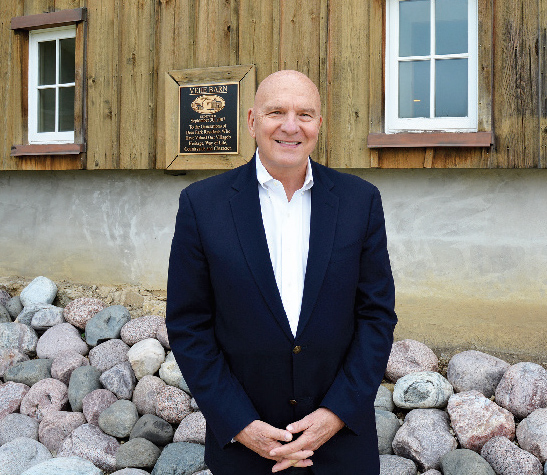
Tomorrow
A Letter from the Village President
By Dale Sands
We have best of both worlds—open spaces with friendly neighbors and an abundance of shopping options. First and foremost, I enjoy and appreciate the people that comprise our community. They are engaged, friendly, and forward looking. Second, I value the semi-rural setting in an urban environment: the open space, the attractive and well-maintained neighborhoods andabundance of parks gives an open feeling. Last, I enjoy the convenience of shopping, entertainment, and restaurant choices we have in Deer Park.
The Village mission statement captures our commitment to our residents and business partners: “To continually improve the quality of life for our residents and business community. We achieve this through strategic planning, adherence to the Village Comprehensive Plan, community engagement, and operating in a fiscally responsible manner. Our focus is on sustainable conscientious development, public safety, preservation of our natural amenities, and fostering our small-town character while being a vibrant, connected, and desirable destination.”
Deer Park is situated in a beautiful rural setting surrounded by parks, ponds, and trails with convenient access to shopping, restaurants, and entertainment options. Community building is one of our priorities. The Village actively engages with Deer Park Town Center to co-sponsor community events such as the highly regarded Jazz and Wine Festival (8/1), Art Festival (9/12-13), and of course fireworks to celebrate the arrival of Santa. The Village hosts community events at the Vehe Farm complex with outdoor concerts, Movie Nights, National Night Out (August 4), Pumpkin Festival (Oct.17) and Santa and Bingo night December 11. We also host the 5K and 10K races at Deer Park Town Center for St. Patrick’s Day and the Cocoa Classic 5K Run in December.
Wide Open Spaces
The Village is surrounded by open space with 12 recently renovated parks situated on 73 acres which compliments the rural setting. Adjacent to Deer Park, our residents enjoy access on the west side of the Village to Cuba Marsh Forest Preserve with 781 acres and over three miles of walking paths to compliment the 6.6 miles of bike and walking trails in the Village. The Deer Grove Forest Preserve, part of the Cook County Forest Preserve, is located on the south side of the Village along Lake Cook road creating nearby resident access to the 2,000-acre Preserve.
Children in Deer Park enjoy convenient access to neighborhood parks with sport fields, walking paths, and playgrounds. The sports fields are in the neighborhood parks for soccer, baseball, softball, and basketball with playgrounds at six parks and tennis courts in three parks. Ela Township recently created a new sport field for lacrosse, located on Deerpath road. The Village parks were renovated in the last 10 years adding walking paths, pavilions at Charles Brown Park and Hamilton Estates Park, and other amenities. Students in Deer Park may attend one of two award winning schools: Barrington Community School District 220 and Lake Zurich School District 95.
So much has happened in Deer Park in the last 20 years with the development of the Deer Park Town Center (celebrating 20 years) and acquisition and development of the Vehe Barn property. Deer Park is one of very few villages in Chicagoland that receives no village income from local property taxes, thus providing residents with lower property tax bills. The growth of Deer Park Town Center has been a catalyst for the development of Deer Park in providing sales tax revenues for street and road resurfacing, drainage improvements and infrastructure, and park improvements across the Village.
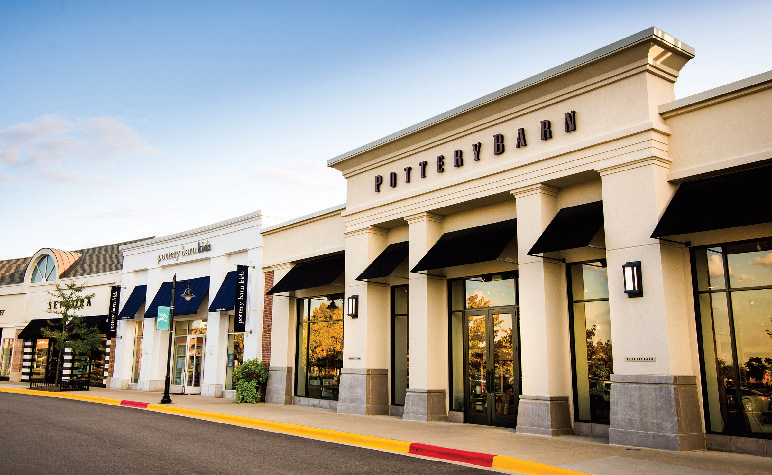
Deer Park Town Center
A Green Power Partner Community
Sustainable development is an important attribute of Deer Park today. The Village prepared its first Sustainability Plan in 2017 and published its first Sustainability Report 2018-2019 in 2020 to capture progress made and future goals for 2020. Part of this plan was to facilitate the development of residential renewable energy systems; the Village pursued and achieved Department of Energy SOLSMART Silver certification which outlines streamlined permitting procedures for residential renewable energy systems. The Village also aggregates the purchase of electricity through a competitive bidding process; in October 2019, the Village selected an Eco Green Aggregation Program, which will acquire wind-based renewable energy certificates equal to our energy needs. Participation in this program also has the feature for Deer Park to be designated a “US Environmental Protection Agency Green Power Partner Community”.
Located in Lake and Cook Counties, residents of Deer Park are near Route 53 for access to Chicago O’Hare Airport. Metro Stations are located in nearby Palatine and Barrington. Today the Village offers diverse living options from luxury apartments in Deer Park Crossing to residential properties with one-acre minimum lot size to senior living accommodations at The Solana Deer Park, an Atria Senior Living Residence. Deer Park also has several office buildings including The Reserve at Deer Park, an eight-story Class A office building which houses Continental and other businesses.
Deer Park is a resident-focused business-friendly forward-looking community today that provides a high quality of life for our residents with open spaces, miles of walking and bicycle paths, and several community and neighborhood parks. The Deer Park Town Center offers local restaurants and entertainment options along with a wide range of retail shopping options.
A New Village Hall
After focusing on infrastructure improvements of street resurfacing, park upgrades and drainage improvements for the last 10 years, the Village Board commissioned the construction of our first Village office: a 4,100 square foot facility located on the Vehe property former farmhouse site. The new office compliments the 14-acre farm setting with historic reconditioned barn and outbuildings; the new office will be dedicated this summer.
In summary, the Village Board of Trustees and the Planning & Zoning Commission endorse three main values:
Commitment to serve: provide safe, well maintained Village with serene neighborhoods, deliver efficient and professional services and treat our residents and business partners with respect.
Enhance Deer Park: provide/enhance quality of life for our residents and visitors, conduct activities that bring the community together, and provide year-round shopping, dining, and entertainment.
Prepare for the Future: provide a vibrant mixed-use environment, be a good neighbor to each other and surrounding communities, and manage change with our business partners, residents, and neighbors to ensure lifestyles and community culture are maintained.
The Future of Deer Park will be based around four major goals to maintain the open rural setting and convenience that was envisioned when the Village was established 63 years ago. Our residents have been surveyed every two years since 2009; their input has been vital to us and is the foundation of the future of Deer Park which is addressed by four main goals:
- Authentic Community Building and Engagement: Continue to build bridges with technology and communication programs;
- Financial Stability and Excellent Economic Development: Maintain a strong financial position with zero debt, staff and business retention, and adherence to the Comprehensive Plan for future development decisions particularly in the Quentin Rd/Lake-Cook Rd/Rand Road Triangle;
- Sustainable Infrastructure and Environmental Stewardship: Continue to invest and maintain village infrastructure, make decisions with sustainability consideration, invest in parks, and engage with neighboring communities to connect trails, neighborhoods and sidewalks; and
- Outstanding leadership, service, and safety: By providing excellent safety and security to residents, benchmark performance against peer villages striving for continuous improvement, and continue to survey residents for feedback on improvement opportunities.
About Village President Sands
Dale Sands was elected to the Village Board of Trustees in 2009 and served two terms as Trustee responsible for infrastructure (roads and drainage) before being elected as Village President in 2017. Dale and his wife, Debra, relocated to Deer Park in 1993 from Maine with their two sons and daughter. Their children attended Barrington 220 Schools. He worked for 40 years in the engineering industry, with 20 years at AECOM where he served as Senior Vice President during the time when AECOM became the worlds’ largest design engineering company. Dale holds BS, MS, and MBA degrees.
– End –
Share this Story



